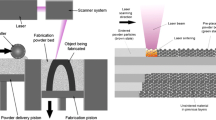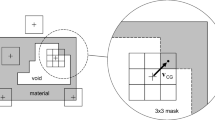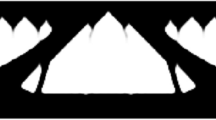Abstract
Although structural design complexities do not potentially pose challenges to many additive manufacturing technologies, several manufacturing constraints should be considered in the design process. One critical constraint is a structure's unsupported or overhanging features. If these features are not reduced or eliminated, they can cause a decline in part surface quality, inhibit print success, or increase production time and cost due to support printing and removal. To eliminate these features, a new post-topology optimization strategy is proposed. The design problem is first topologically optimized, then boundary identification and overhang detection are carried out. Next, additional support-free struts subject to a specified thickness and angle are introduced to support previously detected infeasible features. This addition can increase the structure’s volume; therefore, an optional volume correction stage is introduced to obtain a new but lower volume fraction which will be used in the final topology optimization, boundary identification, and overhang elimination stages. Experimental and numerical load–displacement relationships are established for varying overhang angle thresholds and minimum feature sizes.




















Similar content being viewed by others
References
Sigmund O, Maute K (2013) Topology optimization approaches: A comparative review. Struct Multidiscip Optim 48(6):1031–1055. https://doi.org/10.1007/s00158-013-0978-6
Lambe AB, Czekanski A (2018) “Topology optimization using a continuous density field and adaptive mesh refinement,” 357–373. https://doi.org/10.1002/nme.5617
ASTM (2015) Standard terminology for additive manufacturing – general principles – terminology. ASTM Int i:1–9. https://doi.org/10.1520/F2792-12A.2
Fayazfar H et al (2018) A critical review of powder-based additive manufacturing of ferrous alloys: Process parameters, microstructure and mechanical properties. Mater Des 144:98–128. https://doi.org/10.1016/j.matdes.2018.02.018
Zegard T, Paulino GH (2016) Bridging topology optimization and additive manufacturing. Struct Multidiscip Optim 53(1):175–192. https://doi.org/10.1007/s00158-015-1274-4
Garaigordobil A, Ansola R, Santamaría J, Fernández de Bustos I (2018) “A new overhang constraint for topology optimization of self-supporting structures in additive manufacturing,” Struct Multidisc Optim 1–15. https://doi.org/10.1007/s00158-018-2010-7
Liu J et al (2018) Current and future trends in topology optimization for additive manufacturing. Struct Multidiscip Optim 57(6):2457–2483. https://doi.org/10.1007/s00158-018-1994-3
Plocher J, Panesar A (2019) Review on design and structural optimisation in additive manufacturing: Towards next-generation lightweight structures. Mater Des 183:108164. https://doi.org/10.1016/j.matdes.2019.108164
Hoffarth M, Gerzen N, Pedersen C (2017) “ALM overhang constraint in topology optimization for industrial applications,” 12th World Congress on Struct Multidisc Optim 1–11
Wang X, Zhang C, Liu T (2018) A topology optimization algorithm based on the overhang sensitivity analysis for additive manufacturing. IOP Conf Ser Mater Sci Eng 382:032036. https://doi.org/10.1088/1757-899X/382/3/032036
Brackett D, Ashcroft I, Hague R (2011) “Topology optimization for additive manufacturing,” Proc Solid Freeform Fabr Symp Austin, TX 1:348–362.https://doi.org/10.1017/CBO9781107415324.004
Gaynor AT, Guest JK (2016) Topology optimization considering overhang constraints: Eliminating sacrificial support material in additive manufacturing through design. Struct Multidiscip Optim 54(5):1157–1172. https://doi.org/10.1007/s00158-016-1551-x
Langelaar M (2017) An additive manufacturing filter for topology optimization of print-ready designs. Struct Multidiscip Optim 55(3):871–883. https://doi.org/10.1007/s00158-016-1522-2
Ibhadode O et al (2023) “Topology optimization for metal additive manufacturing: current trends, challenges, and future outlook,” Virtual Phys Prototyp 18(1). https://doi.org/10.1080/17452759.2023.2181192
Toyserkani E, Sarker D, Ibhadode OO, Liravi F, Russo P, Taherkhani K (2021) Metal Additive Manufacturing. Wiley. [Online]. Available: https://books.google.ca/books?id=_ScQswEACAAJ
Langelaar M (2016) Topology optimization of 3D self-supporting structures for additive manufacturing. Addit Manuf 12:60–70. https://doi.org/10.1016/j.addma.2016.06.010
Leary M, Merli L, Torti F, Mazur M, Brandt M (2014) Optimal topology for additive manufacture: A method for enabling additive manufacture of support-free optimal structures. Mater Des 63:678–690. https://doi.org/10.1016/j.matdes.2014.06.015
Mass Y, Amir O (2017) Topology optimization for additive manufacturing: Accounting for overhang limitations using a virtual skeleton. Addit Manuf 18:58–73
Guo X, Zhou J, Zhang W, Du Z, Liu C, Liu Y (2017) Self-supporting structure design in additive manufacturing through explicit topology optimization. Comput Methods Appl Mech Eng 323:27–63
Kuo Y, Cheng C (2019) “Self-supporting structure design for additive manufacturing by using a logistic aggregate function,” Struct Multidisc Optim
van de Ven E, Maas R, Ayas C, Langelaar M, van Keulen F (2020) Overhang control based on front propagation in 3D topology optimization for additive manufacturing. Comput Methods Appl Mech Eng 369:113169. https://doi.org/10.1016/j.cma.2020.113169
Mhapsekar K, McConaha M, Anand S (2018) Additive manufacturing constraints in topology optimization for improved manufacturability. J Manuf Sci Eng 140(May):1–16. https://doi.org/10.1115/1.4039198
Mantovani S, Campo GA, Ferrari A (2021) “Additive manufacturing and topology optimization: A design strategy for a steering column mounting bracket considering overhang constraints,” Proc Inst Mech Eng C J Mech Eng Sci 235(10):1703–1723.https://doi.org/10.1177/0954406220917717
van de Ven E, Maas R, Ayas C, Langelaar M, van Keulen F (2021) Overhang control in topology optimization: a comparison of continuous front propagation-based and discrete layer-by-layer overhang control. Struct Multidiscip Optim. https://doi.org/10.1007/s00158-021-02887-2
Wang C, Zhang W, Zhou L, Gao T, Zhu J (2021) Topology optimization of self-supporting structures for additive manufacturing with B-spline parameterization. Comput Methods Appl Mech Eng 374:113599. https://doi.org/10.1016/j.cma.2020.113599
Zou J, Zhang Y, Feng Z (2021) Topology optimization for additive manufacturing with self-supporting constraint. Struct Multidiscip Optim. https://doi.org/10.1007/s00158-020-02815-w
Zhou M, Lazarov BS, Wang F, Sigmund O (2015) Minimum length scale in topology optimization by geometric constraints. Comput Methods Appl Mech Eng 293:266–282. https://doi.org/10.1016/j.cma.2015.05.003
Liu J, Ma Y (2018) A new multi-material level set topology optimization method with the length scale control capability. Comput Methods Appl Mech Eng 329:444–463. https://doi.org/10.1016/j.cma.2017.10.011
Rong X, Rong J, Zhao S, Li F, Yi J, Peng L (2020) “New method for controlling minimum length scales of real and void phase materials in topology optimization,” Acta Mechanica Sinica/Lixue Xuebao 0123456789. https://doi.org/10.1007/s10409-020-00932-9
Xiong Y, Yao S, Zhao Z-L, Xie YM (2020) A new approach to eliminating enclosed voids in topology optimization for additive manufacturing. Addit Manuf 32:101006. https://doi.org/10.1016/j.addma.2019.101006
Zhou L, Zhang W (2019) “Topology optimization method with elimination of enclosed voids,” 2015
Liu S, Li Q, Chen W, Tong L, Cheng G (2015) An identification method for enclosed voids restriction in manufacturability design for additive manufacturing structures. Front Mech Eng 10(2):126–137. https://doi.org/10.1007/s11465-015-0340-3
Fernández E, Yang K, Koppen S, Alarcón P, Bauduin S, Duysinx P (2020) Imposing minimum and maximum member size, minimum cavity size, and minimum separation distance between solid members in topology optimization. Comput Methods Appl Mech Eng 368:113157. https://doi.org/10.1016/j.cma.2020.113157
Wang C (2021) “Topology Optimization of Self-Supported Enclosed Voids for Additive Manufacturing,” in Volume 2: 41st Computers and Information in Engineering Conference (CIE), American Society of Mechanical Engineers. https://doi.org/10.1115/DETC2021-68785
Langelaar M (2018) Combined optimization of part topology, support structure layout and build orientation for additive manufacturing. Struct Multidiscip Optim 57:1985–2004
Zwier MP, Wits WW (2016) Design for additive manufacturing : Automated build orientation selection and optimization. Procedia CIRP 55:128–133. https://doi.org/10.1016/j.procir.2016.08.040
Cheng L, To A (2019) Part-scale build orientation optimization for minimizing residual stress and support volume for metal additive manufacturing : theory and experimental validation. Comput Aided Des. https://doi.org/10.1016/j.cad.2019.03.004
Olsen J, Kim IY (2020) Design for additive manufacturing: 3D simultaneous topology and build orientation optimization. Struc Multidisc Optim c:1989–2009. https://doi.org/10.1007/s00158-020-02590-8
Dapogny C et al (2018) “Shape and topology optimization considering anisotropic features induced by additive manufacturing processes,” HAL Archives hal01660850v2 1–39. [Online]. Available: https://hal.archives-ouvertes.fr/hal-01660850/%0ahttps://hal.archives-ouvertes.fr/hal-01660850/document
Mirzendehdel AM, Rankouhi B, Suresh K (2018) Strength-based topology optimization for anisotropic parts. Addit Manuf 19:104–113. https://doi.org/10.1016/j.addma.2017.11.007
Hwan J, Bona P, Keun G (2019) Topology optimization and additive manufacturing of customized sports item considering orthotropic anisotropy. Int J Precis Eng Manuf. https://doi.org/10.1007/s12541-019-00163-4
Zhang ZD et al (2020) “Topology optimization parallel-computing framework based on the inherent strain method for support structure design in laser powder-bed fusion additive manufacturing,” Int J Mech Mater Des 0123456789. https://doi.org/10.1007/s10999-020-09494-x
Allaire G, Bogosel B (2018) Optimizing supports for additive manufacturing. Struct Multidiscip Optim 58(6):2493–2515. https://doi.org/10.1007/s00158-018-2125-x
Vaidya R, Anand S (2016) Optimum support structure generation for additive manufacturing using unit cell structures and support removal constraint. Procedia Manuf 5:1043–1059. https://doi.org/10.1016/j.promfg.2016.08.072
Harl B, Predan J, Gubeljak N, Kegl M (2020) Influence of variable support conditions on topology optimization of load-carrying parts. Tehnicki Vjesnik 27(5):1501–1508. https://doi.org/10.17559/TV-20191001212144
Pellens J, Lombaert G, Michiels M, Craeghs T, Schevenels M (2020) Topology optimization of support structure layout in metal-based additive manufacturing accounting for thermal deformations. Struct Multidiscip Optim 61(6):2291–2303. https://doi.org/10.1007/s00158-020-02512-8
Giraldo-londoño O, Mirabella L, Dalloro L, Paulino GH (2020) Multi-material thermomechanical topology optimization with applications to additive manufacturing: Design of main composite part and its support structure. Comput Methods Appl Mech Eng 363:112812. https://doi.org/10.1016/j.cma.2019.112812
Allaire G, Jakabčin L (2017) Taking into account thermal residual stresses in topology optimization of structures built by additive manufacturing. Math Models Methods Appl Sci 28(12):1–45. https://doi.org/10.1142/S0218202518500501
Xu S, Liu J, Ma Y (2022) Residual stress constrained self-support topology optimization for metal additive manufacturing. Comput Methods Appl Mech Eng 389:114380. https://doi.org/10.1016/j.cma.2021.114380
Cheng L, Liang X, Bai J, Chen Q, Lemon J, To A (2019) On utilizing topology optimization to design support structure to prevent residual stress induced build failure in laser powder bed metal additive manufacturing. Addit Manuf 27(November 2018):290–304. https://doi.org/10.1016/j.addma.2019.03.001
van de Ven E, Maas R, Ayas C, Langelaar M, van Keulen F (2018) Continuous front propagation-based overhang control for topology optimization with additive manufacturing. Struct Multidiscip Optim 57(5):2075–2091. https://doi.org/10.1007/s00158-017-1880-4
Zhao D, Li M, Liu Y (2020) A novel application framework for self-supporting topology optimization. Visual Computer. https://doi.org/10.1007/s00371-020-01860-2
Bi M, Tran P, Xie YM (2020) Topology optimization of 3D continuum structures under geometric self-supporting constraint. Addit Manuf 36(May):101422. https://doi.org/10.1016/j.addma.2020.101422
Paper C (2017) “A modified inherent strain method for fast prediction of residual deformation in additive manufacturing of metal parts,” Solid Freeform Fabr Symp (August):2539–2545
Liu Y, Yang Y, Wang D (2016) “A study on the residual stress during selective laser melting (SLM) of metallic powder,” Int J Adv Manuf Technol 1–10. https://doi.org/10.1007/s00170-016-8466-y
Matthews M, Trapp J, Guss G, Rubenchik A (2018) Direct measurements of laser absorptivity during metal melt pool formation associated with powder bed fusion additive manufacturing processes. J Laser Appl 30(3):032302. https://doi.org/10.2351/1.5040636
Kranz J, Herzog D, Emmelmann C (2015) Design guidelines for laser additive manufacturing of lightweight structures in TiAl6V4. J Laser Appl 27(S1):S14001. https://doi.org/10.2351/1.4885235
Fox JC, Moylan SP, Lane BM (2016) Effect of process parameters on the surface roughness of overhanging structures in laser powder bed fusion additive manufacturing. Procedia CIRP 45:131–134. https://doi.org/10.1016/j.procir.2016.02.347
Allison J, Sharpe C, Seepersad CC (2019) Powder bed fusion metrology for additive manufacturing design guidance. Addit Manuf 25(June 2018):239–251. https://doi.org/10.1016/j.addma.2018.10.035
Leary M, Babaee M, Brandt M, Subic A (2013) Feasible build orientations for self-supporting fused deposition manufacture: a novel approach to space-filling tesselated geometries. Adv Mat Res 633:148–168. https://doi.org/10.4028/www.scientific.net/AMR.633.148
Ibhadode O, Zhang Z, Rahnama P, Bonakdar A, Toyserkani E (2020) “Topology optimization of structures under design-dependent pressure loads by a boundary identification-load evolution ( BILE ) model,” Struct Multidisc Optim
Fu Y et al (2019) “Design and experimental validation of self-supporting topologies for additive manufacturing,” Virtual Phys Prototyp 2759. https://doi.org/10.1080/17452759.2019.1637023
Clausen A, Aage N, Sigmund O (2016) Exploiting additive manufacturing infill in topology optimization for improved buckling load. Engineering 2(2):250–257. https://doi.org/10.1016/J.ENG.2016.02.006
Qian X (2017) Undercut and overhang angle control in topology optimization: A density gradient based integral approach. Int J Numer Methods Eng 111(3):247–272. https://doi.org/10.1002/nme.5461
Driessen AM (2016) “Overhang constraint in topology optimization for additive manufacturing: a density gradient based approach,” [Online]. Available: http://repository.tudelft.nl/islandora/object/uuid%3Af95235fc-4e81-48d2-9e2b-ba03d3c734d5?collection=education
Rozvany GIN, Zhou M, Birker T (1992) Generalized shape optimization without homogenization. Struct Optim 4(3–4):250–252. https://doi.org/10.1007/BF01742754
Rozvany GIN (2009) A critical review of established methods of structural topology optimization. Struct Multidiscip Optim 37(3):217–237. https://doi.org/10.1007/s00158-007-0217-0
Bendsøe MP, Sigmund O (1999) Material interpolation schemes in topology optimization. Arch Appl Mech 69(9–10):635–654. https://doi.org/10.1007/s004190050248
Ibhadode O, Zhang Z, Bonakdar A, Toyserkani E (2021) IbIPP for topology optimization - an image-based initialization and post-processing code written in MATLAB. SoftwareX 14:100701. https://doi.org/10.1016/j.softx.2021.100701
Sigmund O (2001) A 99 line topology optimization code written in matlab. Struct Multidiscip Optim 21(2):120–127. https://doi.org/10.1007/s001580050176
ASTM E8 (2010) “ASTM E8/E8M standard test methods for tension testing of metallic materials 1,” Annual Book ASTM Standards 4(C):1–27. https://doi.org/10.1520/E0008
Esmaeilizadeh R et al (2021) On the effect of laser powder-bed fusion process parameters on quasi-static and fatigue behaviour of Hastelloy X: A microstructure/defect interaction study. Addit Manuf 38(December 2020):101805. https://doi.org/10.1016/j.addma.2020.101805
Esmaeilizadeh R et al (2020) “Customizing mechanical properties of additively manufactured Hastelloy X parts by adjusting laser scanning speed,” J Alloys Compd 812. https://doi.org/10.1016/j.jallcom.2019.152097
Alafaghani A, Qattawi A, Ablat MA (2017) Design consideration for additive manufacturing: fused deposition modelling. Open J Appl Sci 07(06):291–318. https://doi.org/10.4236/ojapps.2017.76024
Meng L et al (2019) From topology optimization design to additive manufacturing: today’s success and tomorrow’s roadmap. Arch Comput Methods Eng 0123456789:1–26. https://doi.org/10.1007/s11831-019-09331-1
Li S, Yuan S, Zhu J, Wang C, Li J, Zhang W (2020) Additive manufacturing-driven design optimization: Building direction and structural topology. Addit Manuf 36(1):101406. https://doi.org/10.1016/j.addma.2020.101406
Yang KK, Zhu JH, Wang C, Jia DS, Song LL, Zhang WH (2018) Experimental validation of 3D printed material behaviors and their influence on the structural topology design. Comput Mech 61(5):581–598. https://doi.org/10.1007/s00466-018-1537-1
Zhu J-H, Yang K-K, Zhang W-H (2016) Backbone cup – a structure design competition based on topology optimization and 3D printing. Int J Simul Multi Design Optim 7:A1. https://doi.org/10.1051/smdo/2016004
Acknowledgements
The authors would like to acknowledge the funding support received from the Natural Sciences and Engineering Research Council of Canada (NSERC), the Federal Economic Development Agency for Southern Ontario (FedDev Ontario), Siemens Canada Limited, and Petroleum Technology Development Fund (PTDF).
Funding
The authors appreciate all funding bodies. The authors also appreciate Jerry Ratthapakdee and Francis Dibia for their roles in printing and photo-capturing some of the sample structures presented in this work.
Author information
Authors and Affiliations
Contributions
Osezua Ibhadode conceived and designed the study. Material preparation, data collection and analysis were performed by Osezua Ibhadode. The first draft of the manuscript was written by Osezua Ibhadode and reviewed by Zhidong Zhang. Ali Bonakdar and Ehsan Toyserkani supervised, reviewed, and funded the project. All authors read and approved the final manuscript.
Corresponding author
Ethics declarations
Conflict of interest
On behalf of all authors, the corresponding author states that there is no conflict of interest.
Additional information
Publisher's Note
Springer Nature remains neutral with regard to jurisdictional claims in published maps and institutional affiliations.
Rights and permissions
Springer Nature or its licensor (e.g. a society or other partner) holds exclusive rights to this article under a publishing agreement with the author(s) or other rightsholder(s); author self-archiving of the accepted manuscript version of this article is solely governed by the terms of such publishing agreement and applicable law.
About this article
Cite this article
Ibhadode, O., Zhang, Z., Bonakdar, A. et al. A post-topology optimization process for overhang elimination in additive manufacturing: design workflow and experimental investigation. Int J Adv Manuf Technol 129, 221–238 (2023). https://doi.org/10.1007/s00170-023-12282-4
Received:
Accepted:
Published:
Issue Date:
DOI: https://doi.org/10.1007/s00170-023-12282-4




